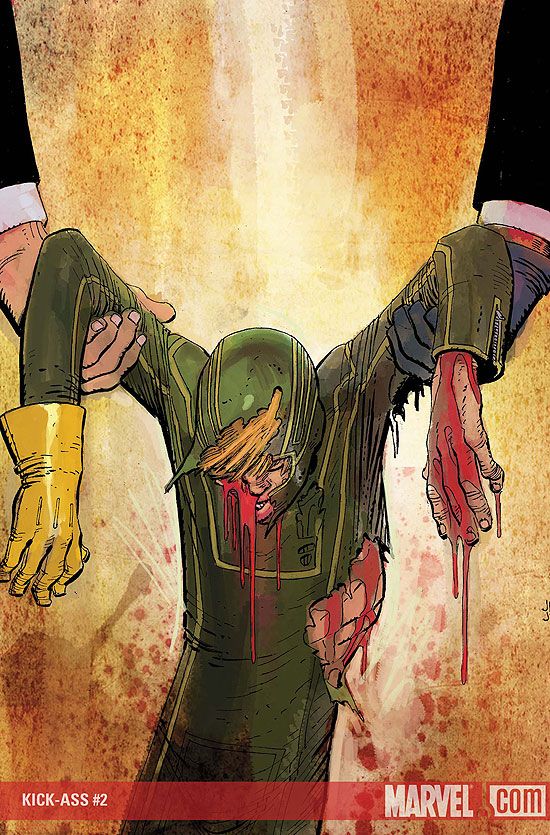Because Mark Millar emphatically promoted "Kick-Ass" as "realistic super-heroes," in many ways the series succeeds or fails according to how well it lives up to that concept. Millar, and artistic collaborator John Romita, Jr., don't use the 1980s notion of superhero "realism," in which supernatural characters were placed in a more brutally violent context, such as Alan Moore's work on "Miracleman" or Frank Miller's "Dark Knight Returns" or "Batman: Year One." Instead, they take a regular teenage kid (maybe not so regular--he's a comic book fan) and show what happens to him when he cobbles together a costume and tries to operate as a crime-fighter.
Judged according to the criteria of realism, the series fails, and issue #2 is a good example of why. We find out that between issue #1 and #2, Dave, the main character, was brought to the hospital following his horrific run-in with a car. (The car ran into him, actually, breaking bones, collapsing a lung, smashing his skull.) Apparently, according to what young Dave can piece together, he removed his costume and stashed it away sometime before the ambulance arrived. That's clearly a violation of the "realism" of the series, since no one in that physical state could have undressed at all. If you've ever had a broken limb, you know how improbable the situation would be. Now imagine doing such at thing with several broken limbs. Impossible. And then, as soon as Dave is off his crutches, he's back on the streets, in costume, getting into fights. If you've ever had to recover from a serious injury, you know that as soon as you're off crutches, you're not doing anything all that athletic. And even if, like Dave, you have a couple of sticks to whack bad guys with, you really aren't in any shape to fight as your limbs are still healing. It's these kinds of moments that contradict the stated claims for the series.
But, that's the problem with authorial intent. "Kick-Ass" fails by the standard as stated by Millar, but it does succeed on other levels.
It's a good story, even if it relies on a degree of superhuman healing. Even if the character doesn't exactly follow the rules of our reality. Even if the blood flows a little too freely in the fight scenes.
It's not "reality," but that doesn't mean it's not a good comic.
First of all, Romita Jr., makes a noble attempt to capture a less-superheroic posture for the main character. When Kick-Ass fights (and, yes, that is the hero's name, although he's not called that in the comic as far as I can tell -- but the script excerpt in the back identifies him by that name), he's not shown leaping through the air in gracefully violent poses. He's not Daredevil or Spider-Man, or even Wild Dog (a late 1980s attempt at realism--if you don't remember him, he wore a hockey mask and carried an uzi) or Casey Jones (who also wore a hockey mask as a supporting character in the "Teenage Mutant Ninja Turtles" series). All of those characters had moments where they were shown in heroically posed action shots, but here, Romita Jr. gives us a hero who is on the ground kicking furiously. A character who lashes out without style. A character who is caught on camera, not in an iconic hero shot, but hunched over, blood dripping from his face. Romita makes us feel the heavy breathing and the pain.
Second, Millar isn't merely exploring what a "real" superhero would be like. He's exploring the intersection between superheroics and the mass media. One of the earliest promotional tools used to sell "Kick-Ass," well before the series even launched, was a YouTube video of a fight between someone dressed in a costume and a bunch of street punks. In issue #2, that video becomes part of the series, and according to Millar's own statement in the back matter to the first two issues, that kind of overlap will become an increasingly important part of the comic moving forward. You could say it's just an attempt at cross-promotion, but it's really just a way to expand the text of the story outside the confines of the comic book page.
Ultimately, "Kick-Ass" #2 is a good comic. It may not fit squarely into the realm of realism, but it succeeds on other levels. It might be worth reading just to see Romita Jr.'s attempt to choreograph a different kind of fight scene from what we normally see in one of his comics. It might be worth reading to see how Millar weaves a real-world media perspective into the story. It might be reading because it's an interesting story about the suffering this character is willing to endure.
But it is worth reading. Certainly.

